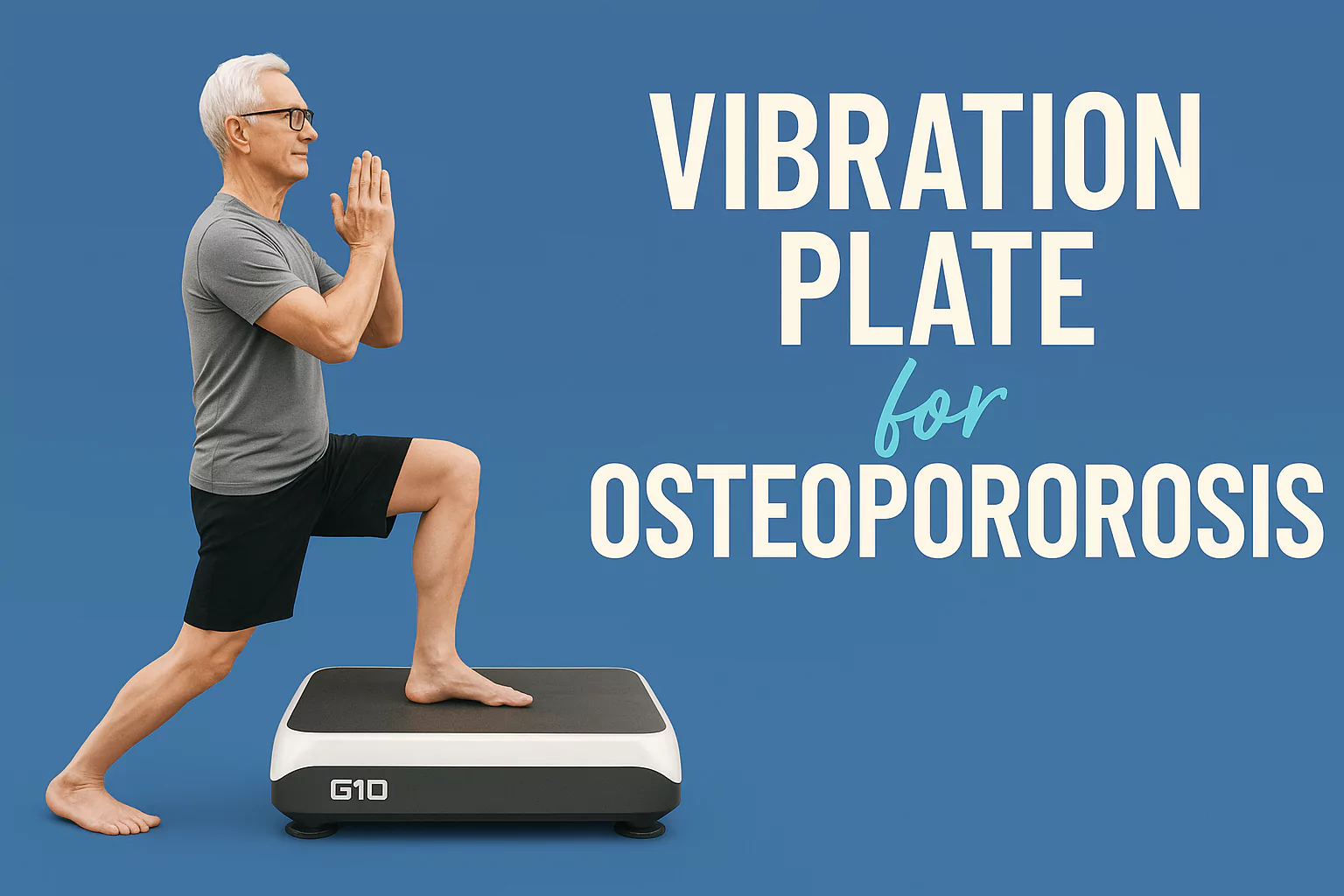
To help osteoporosis with a vibration plate, set the platform to a low-to-moderate 10-18 Hz, stand in a soft‐knee “athletic” stance, and run 1–2-minute bouts for a total of ~10 minutes, three times a week.
Studies show that this dosage safely loads the hips & spine, stimulates osteoblast activity, and can lift bone-mineral density while improving balance and fall-resistance.
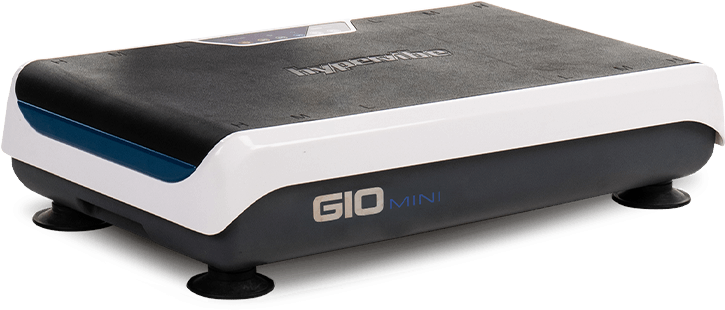




Best vibration-plate exercises for fragile bones:
| # | Exercise | Primary sites loaded | Safe starting settings* | Why it matters |
|---|---|---|---|---|
| 1 | Mini-Squat | Hips, knees, spine | 15 Hz • 90 s | Classic weight-bearing move that targets the femoral neck—a frequent fracture site. |
| 2 | Heel Raise | Ankles, calves, hips | 12-18 Hz • 60 s | Trains balance and loads the calcaneus & tibia without shearing the joints. |
| 3 | Lateral Step-Up | Hips, glutes, core | 18 Hz • 60 s each leg | Side loading stimulates hip abductors and improves gait stability. |
| 4 | Bridge | Lumbar spine, glutes | 12 Hz • 60 s | Directly strengthens posterior chain and counters vertebral compression. |
| 5 | Modified Push-Up | Wrists, shoulders, thoracic spine | 8-12 Hz • 60 s | Gentle upper-body load shown to benefit wrist/forearm BMD. |
| 6 | Standing Warm-Up → Mid-Range Squat combo | Whole body | 8 Hz (2 min) → 15 Hz (90 s) | Progressive loading primes joints before deeper work. |
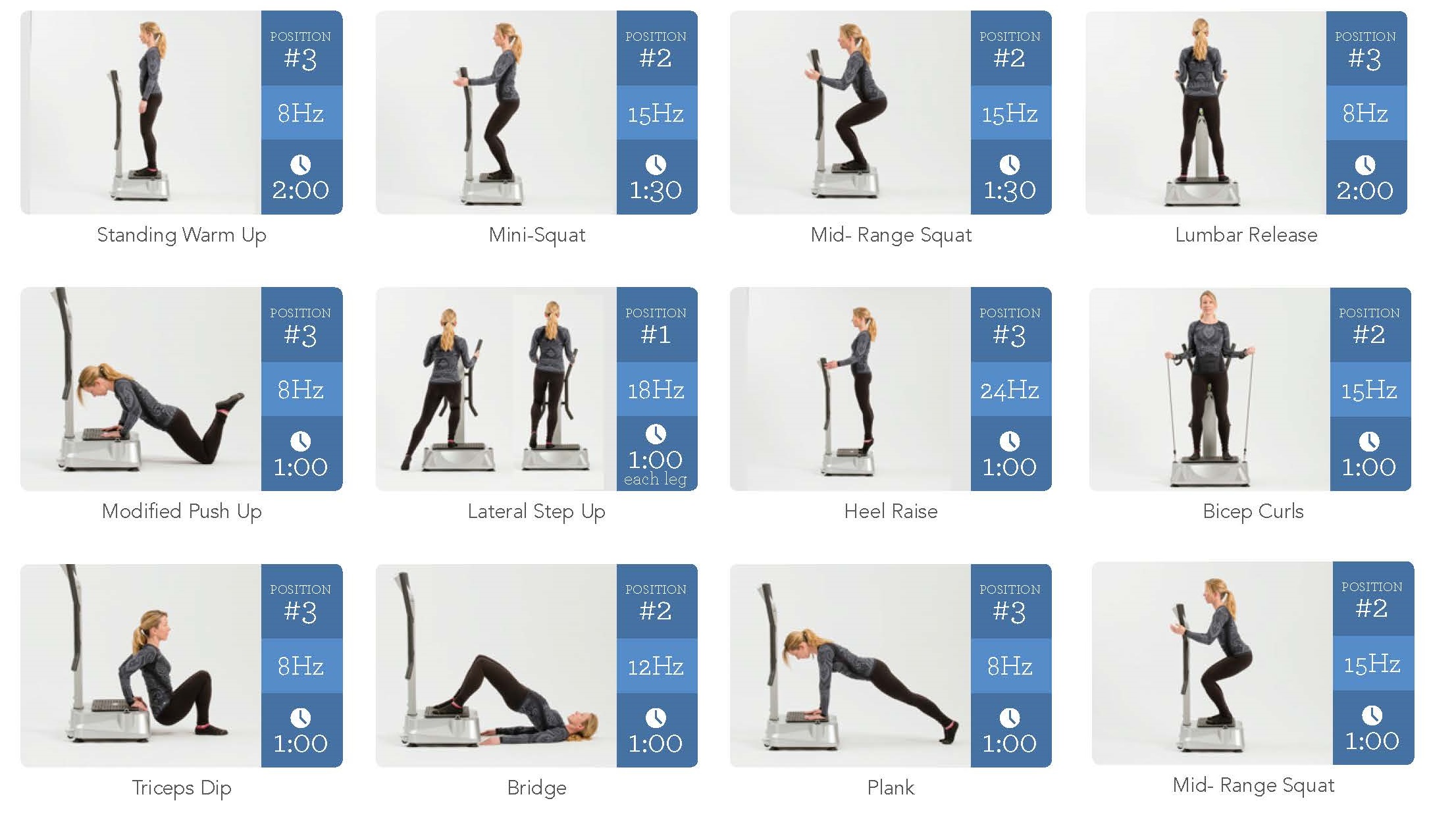
Our experts pro tips for safe, bone-building sessions:
Osteoporosis is a systemic skeletal disorder in which two measurable changes occur:
The condition is usually silent until a fracture happens, but it is common: roughly one in three women and one in five men over 50 will suffer an osteoporotic fracture during their lifetime.
Risk rises with age, estrogen or androgen deficiency, long-term glucocorticoid therapy, smoking, excessive alcohol, and many chronic diseases.
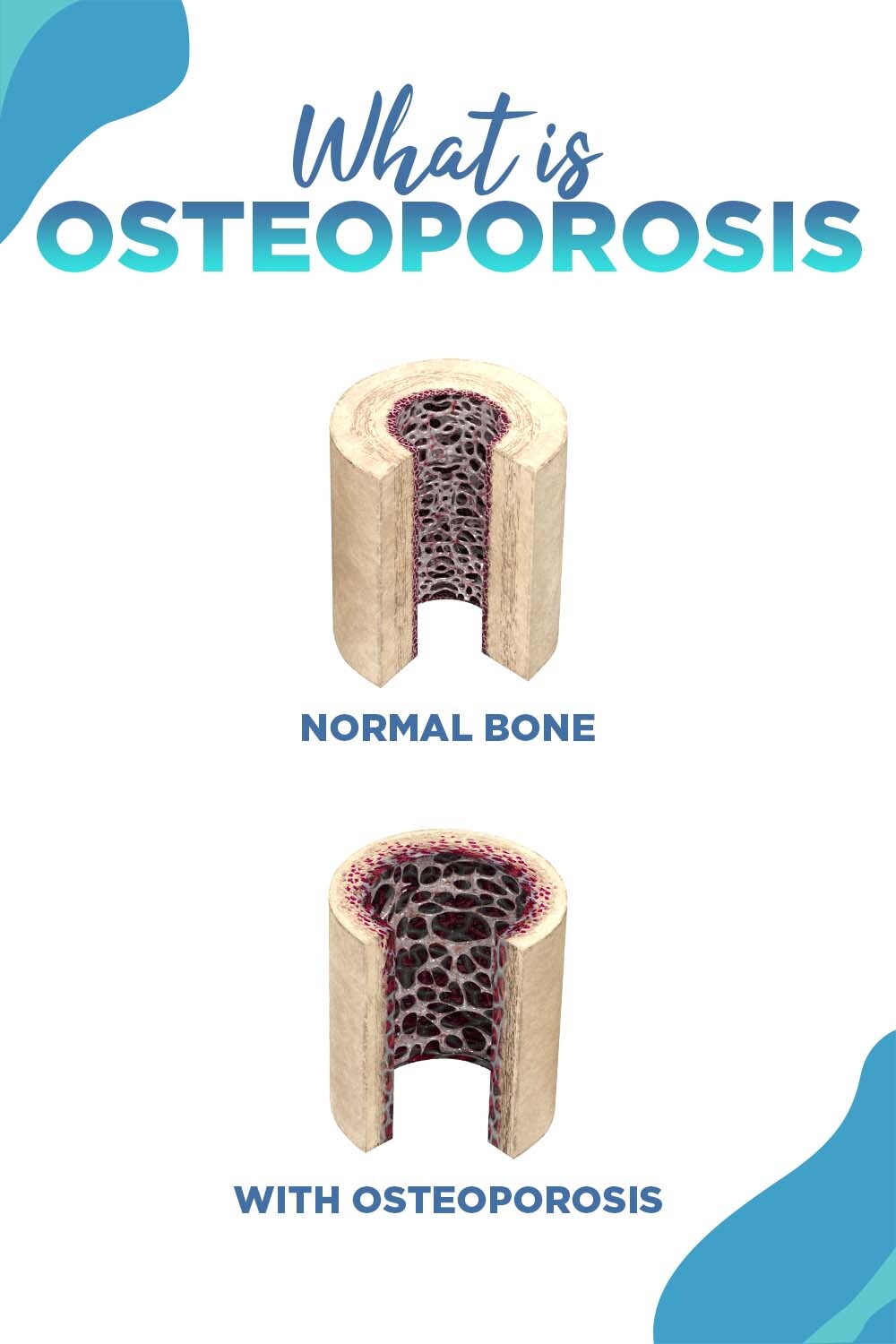
Bones aren’t static; they bend a tiny bit every time you walk or lift something.
That bend is measured in micro-strain (μɛ)—roughly 200-3 000 μɛ during normal activity.
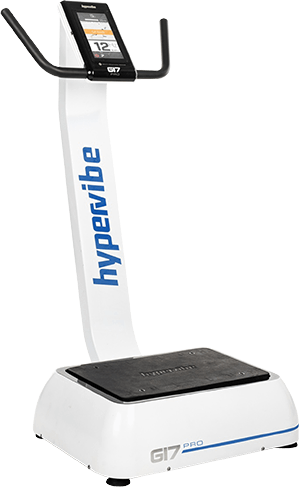




| Key factor | Evidence-based detail | Why it stays “low-impact” |
|---|---|---|
| Tiny travel, fast cycles | Platforms typically move 1–5 mm at 10–50 Hz. | The displacement is too small to produce jarring ground-reaction spikes. |
| Sub-gravity acceleration | “Low-intensity vibration” is defined as < 1 g; users never leave the plate. | Keeps load below the jump/run threshold that stresses joints. |
| Mechanical damping up the skeleton | Only ≈40 % of foot acceleration reaches the knee and ≈10 % reaches the hip. | Soft tissues and joint flexion absorb most of the energy before it hits vulnerable sites. |
| Joint forces lower than walking | Total knee/hip contact forces during WBV stayed ≤ 79 % of those measured while walking; vibration-induced increments were just 5–27 % of body-weight load. | Shows the session is biomechanically “lighter” than a stroll. |
| Osteogenic micro-strain at safe dosage | Daily 0.3 g, 30 Hz WBV for 12 months increased lumbar and femoral bone mass in young women. | Confirms that very small cyclic forces (well below impact sports) are enough to activate osteoblasts. |
The plate delivers thousands of gentle vertical pulses each minute.
Because the pulses are small (< 1 g) and most of the vibration is damped before it reaches major joints.
The compressive forces that do arrive are lower than everyday walking yet frequent enough to create the tiny bone strains that switch osteocytes on.
That combination—low magnitude, high repetition—gives you bone-building stimulus without high-impact stress.
The idea came from NASA-funded counter-measure research in the early 2000s.
Clinton Rubin’s team showed that exposing tail-suspended rats to 0.2 g, 30 Hz vibration for 10 min/day completely halted micro-gravity-like bone loss.
The same low-magnitude, high-frequency signal was then tested in a 12-month, double-blind trial of 70 post-menopausal women: those who used the plate twice daily (2 × 10 min) lost ≈1 % less spine BMD and 2 % less femoral-neck BMD than sham controls, with the greatest protection in subjects who stood on the plate at least 80 % of prescribed time.
Subsequent 56-day head-down-tilt bed-rest studies for NASA showed that resistive vibration exercise further blunted the trabecular and cortical losses normally seen in long-duration unloading.
Key clinical evidence.
Overall, WBV yields modest, but measurable osteogenic effects—comparable to other low-impact exercises—when delivered at ≤1 g for 10–20 min per session, at least three times per week, over six months or longer.
As a general recommendation, we encourage you to practice WBV exercises that target different body areas,
even if you’re not looking to build muscles, as this helps with posture, flexibility and overall muscle tone.
With osteoporosis, it’s not only the bones in your lower body that get weaker – the spine and upper body are also affected,
so you should included exercises for these body areas in your routine as well.
For the upper body exercises on your Hypervibe vibration machine, it may be necessary to decrease the frequency even more,
and for those targeting the core and abs, you may need to reduce the duration to just 30 seconds at the beginning, to avoid head vibrations and dizziness.
Just remember to keep the proper posture and try to do as much as you can from this workout.
Hydrate yourself properly and grab a small snack prior to the WBV training session if needed.
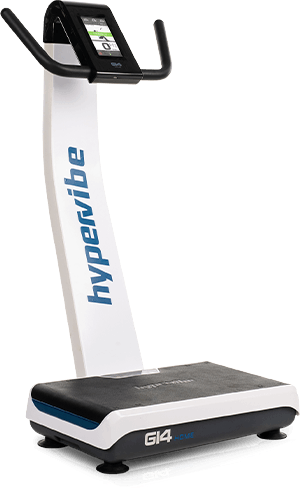




Skip the plate and speak to your physician if you have a pacemaker/ICD, recent vertebral or hip fracture, joint arthroplasty, pregnancy, uncontrolled hypertension, epilepsy, deep-vein thrombosis or kidney stones.
Current WBV guidelines list these as absolute or strong relative contraindications.
Step on in flat shoes or barefoot, feet shoulder-width, knees softly bent, spine neutral, core braced.
Grip the side handles only when balance is an issue; the unlocked knees cut vibration transmission to the head while protecting the lumbar discs.
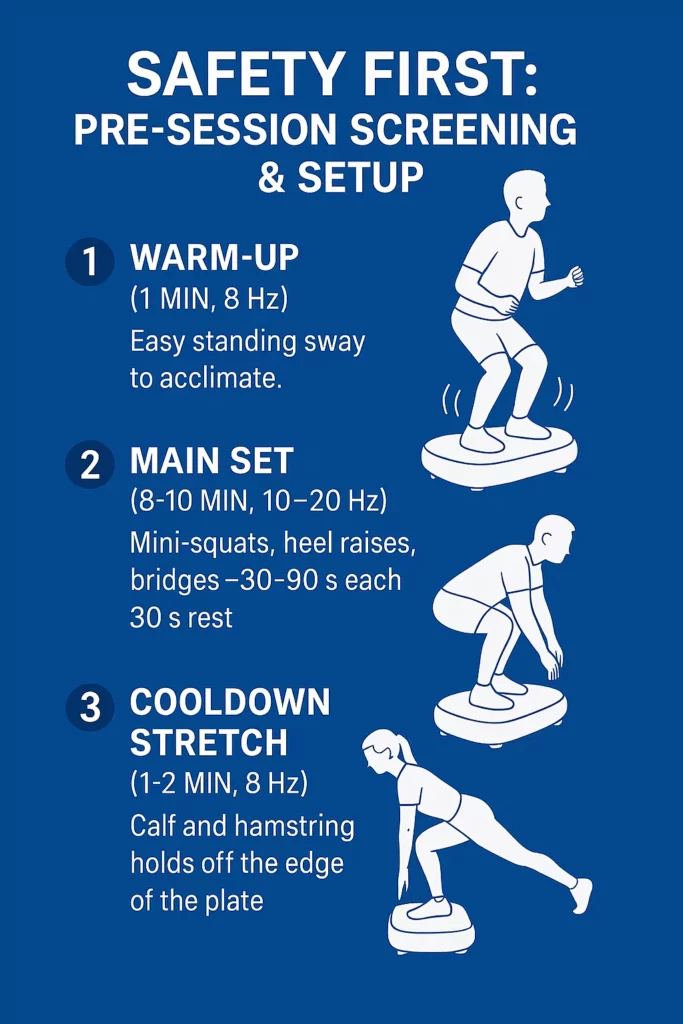
Safety First Pre-Session Screening & Setup
Session structure.
This pattern meets published dosing models while keeping joint forces below walking levels.
Start with this 10-minute, 8-exercise circuit at 10–18 Hz to load hips, spine and wrists safely.
| # | Exercise | Hz | Time | Main bones loaded |
|---|---|---|---|---|
| 1 | Standing warm-up | 8 | 2:00 | Whole skeleton |
| 2 | Mini-squat | 15 | 1:30 | Femoral neck, lumbar spine |
| 3 | Heel raise | 12 | 1:00 | Calcaneus, tibia, hip |
| 4 | Bridge (supine) | 12 | 1:00 | Lumbar vertebrae, sacrum |
| 5 | Lateral step-up | 18 | 1:00 / leg | Proximal femur, pelvis |
| 6 | Modified push-up (hands on plate) | 10 | 1:00 | Radius, ulna, thoracic spine |
| 7 | Pelvic tilt / core hold | 10 | 0:30 | Vertebral column, ribs |
| 8 | Calf stretch cool-down | 8 | 1:00 | Ankle, foot |
If you complete all eight beginner drills with good form and no next-day soreness, add +2 Hz every fourth week, topping out at 22–24 Hz for lower-body work and ≤18 Hz for upper-body or core.
Keep amplitude 2–4 mm; stop the raise if dizziness or joint pain appears.
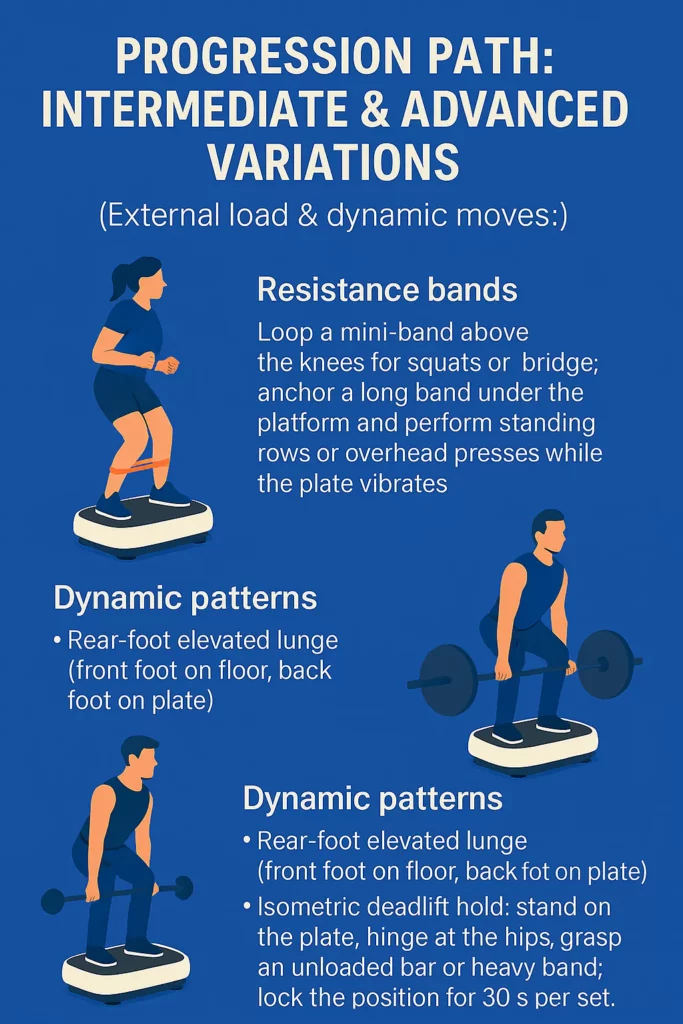
Progression Path (Intermediate & Advanced Variations)
External load & dynamic moves:
| Day | Focus | Typical settings | Time |
|---|---|---|---|
| Mon | Strength + bands | 14–20 Hz | 12 min |
| Wed | Mobility / balance | 10–14 Hz | 10 min |
| Fri | Power & dynamic | 18–24 Hz | 12–15 min |
Walk, stretch, or perform light resistance training on non-vibration days to complement bone loading without over-taxing joints.
Nutrition is where you should start to fast base your bone healing to its normal astatre
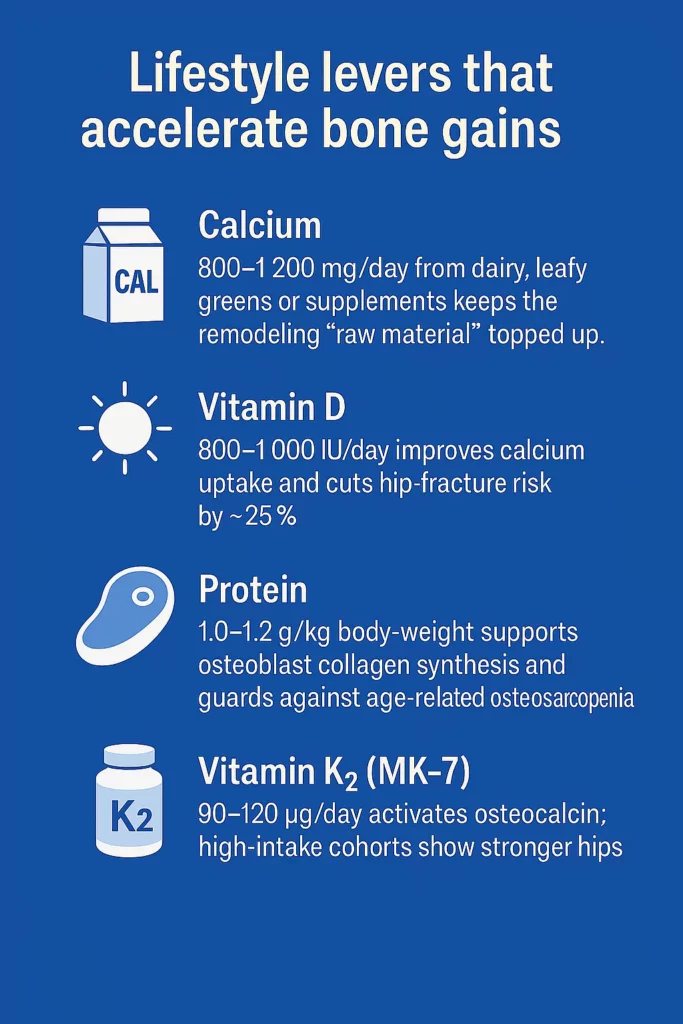
Lifestyle levers that accelerate bone gains
Strength synergy:
Twice-weekly progressive resistance sessions (e.g., machines, free weights)
add site-specific loading that vibration alone can’t match and raise hip-spine BMD in older adults.
Fall-proofing:
Off-plate balance drills—single-leg stands,
tandem walks—or a 20-minute Tai Chi class three times weekly cut fall incidence and improve postural sway.
Combine these levers with your WBV schedule to supply the nutrients,
muscular forces and neuromotor control needed for maximal bone accrual and fracture prevention.
After a recent vertebral compression fracture, avoid vibration plates for the first 6-8 weeks.
When your physician confirms healing, you may begin only low-intensity platforms (< 0.4 g); high-g whole-body vibration remains contraindicated for fracture patients.
DXA’s error margin (~1 %) means you need at least 6–12 months of therapy to see a real BMD change; guidelines therefore schedule repeat scans every 1–2 years, though some whole-body vibration trials showed about 2 % lumbar gains after 6 months.
Low-intensity vibration (LIV < 0.4 g) mainly maintains BMD—two-year trials showed ≤1 % spine change.
Whole-body vibration (WBV > 1 g, 2–4 mm) yields 1–3 % lumbar gains within 6–12 months in post-menopausal RCTs and meta-analyses, making WBV clearly more effective
Choose the Hypervibe G14 Home: 5–30 Hz, 8 mm travel (≈14 g), 60 kg footprint, 140 kg user limit, 7-inch touchscreen and pre-set programs—delivers the full bone-building range without the cost or size of the clinic-grade G17 Pro.

To use a vibration plate for weight loss, stand, squat,...
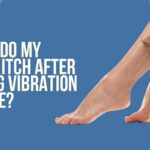
Lately, vibration therapy (VT) has been finding implementation in more...

The lymphatic system, also called the lymphoid system, is an...

Taking into consideration the growing popularity of the vibration plate,...

Most probably you are already familiar with the body vibration...